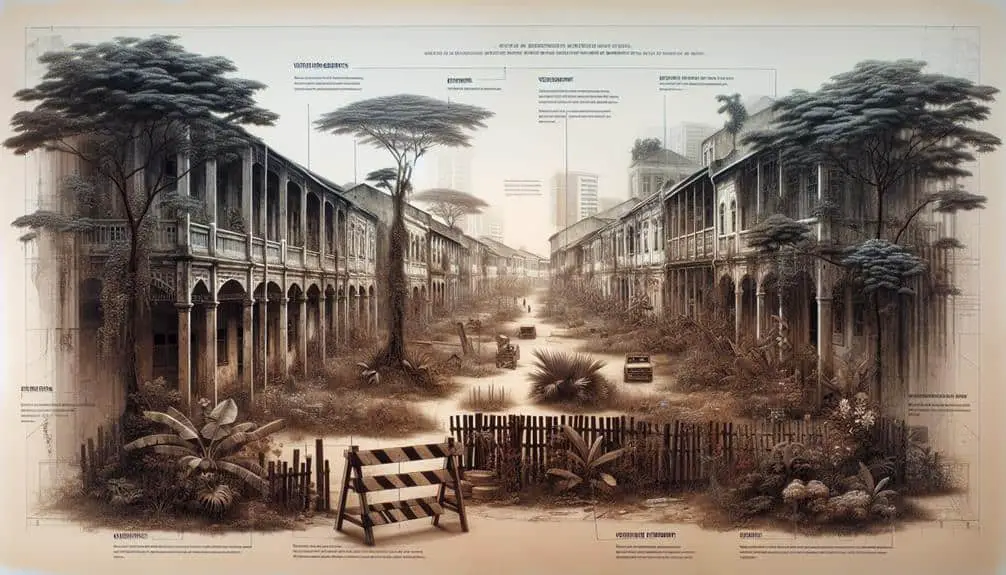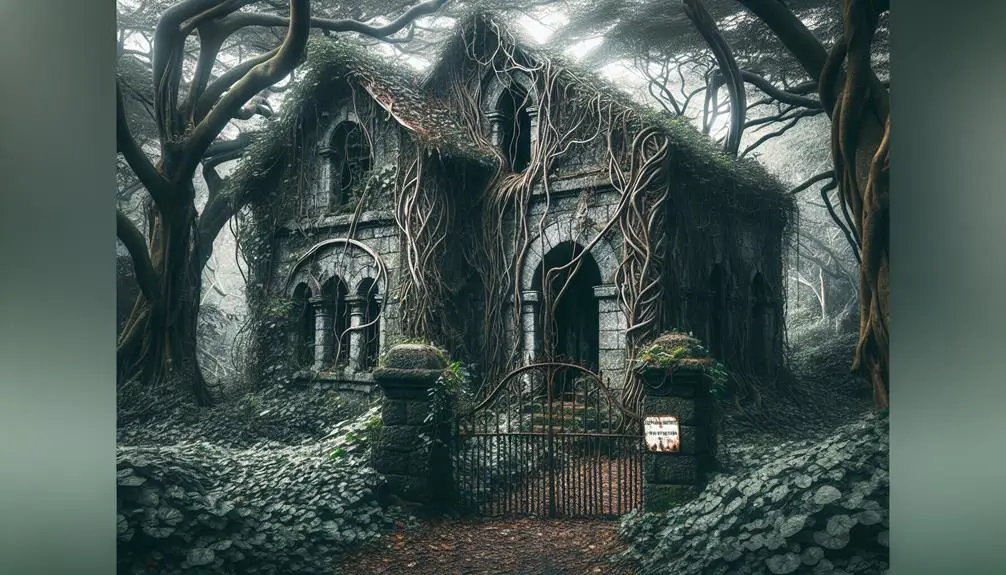Preserving colonial ghost town remnants involves thorough historical research, archaeological surveys, and excavation of artifacts to uncover insights. Structural stabilization and conservation are essential, with architectural restoration and use of compatible materials maintaining authenticity. Community engagement fosters appreciation, guided tours generate interest, and educational programs enhance understanding. Adequate funding through partnerships, fundraising, and grant opportunities is critical for upkeep. Leveraging the historical significance for tourism development, marketing campaigns, guided tours, and social media promotions attract visitors. This multifaceted approach guarantees the preservation and promotion of colonial ghost town remnants.
Key Points
- Structural stabilization ensures the safety and longevity of historical buildings.
- Conservation efforts maintain authenticity and historical accuracy.
- Community engagement fosters appreciation and understanding of colonial heritage.
- Securing funding through partnerships and initiatives supports preservation projects.
- Tourism development leverages historical significance for sustainable growth and promotion.
Historical Documentation and Research
When conducting historical documentation and research on colonial ghost town remnants, it's important to thoroughly analyze primary sources for accurate insights into the past. Archaeological surveys play a vital role in uncovering tangible remnants of life in these abandoned settlements. By meticulously excavating and studying artifacts, structures, and even human remains, archaeologists can piece together the daily lives and societal structures that once thrived in these now-desolate locations.
In addition to archaeological surveys, archival research provides a wealth of information about the people who inhabited these ghost towns. Delving into old records, letters, photographs, and official documents can offer valuable context to the physical remnants unearthed through excavations. By cross-referencing archaeological findings with historical records, researchers can construct a more detailed narrative of the events that led to the abandonment of these towns and the lives of their former residents. Through a combination of archaeological surveys and archival research, the mysteries surrounding colonial ghost town remnants can slowly be unraveled, shedding light on a bygone era.
Structural Stabilization and Conservation
To guarantee the long-term preservation of colonial ghost town remnants, structural stabilization and conservation efforts must be meticulously planned and executed to safeguard the remaining historical structures from further decay and destruction. Architectural restoration plays an essential role in maintaining the authenticity and integrity of these structures. Preservation techniques such as consolidating unstable masonry, repairing deteriorated wooden elements, and reinforcing foundations are vital in ensuring the structural stability of buildings within the ghost town.
In architectural restoration, it's imperative to use compatible materials that match the original construction to retain historical accuracy. Professional conservationists employ advanced technologies like 3D scanning and modeling to document the existing structures before initiating any restoration work. This detailed documentation aids in accurately reproducing missing architectural elements and assists in identifying areas that require immediate attention.
Community Engagement and Education
Engaging the local community and providing educational resources are essential components in fostering a deeper appreciation for the historical significance of colonial ghost town remnants. Community engagement plays an important role in building connections between residents and their heritage. Hosting engagement events such as guided tours, historical reenactments, and workshops can generate interest and intrigue among locals. These events not only bring the community together but also create a sense of ownership and pride in preserving these historical sites.
Educational programs are necessary in enhancing public understanding of colonial ghost towns. By offering workshops, lectures, and educational materials, individuals can learn about the history, architecture, and daily life of those who once inhabited these towns. Schools, museums, and local organizations can collaborate to develop curriculum-based programs that cater to students of all ages, ensuring that future generations are aware of and invested in the preservation efforts.
Funding and Grant Opportunities
Securing adequate funding and exploring available grant opportunities are essential steps in ensuring the preservation and maintenance of colonial ghost town remnants. Preservation partnerships with government agencies, historical societies, and private organizations play a pivotal role in funding conservation projects. By collaborating with these entities, resources can be pooled to support the preservation efforts of colonial ghost town remnants.
Fundraising initiatives are another key aspect of securing the necessary financial support for maintaining these historical sites. Organizing events such as benefit concerts, charity auctions, or crowdfunding campaigns can help raise funds for the upkeep and restoration of colonial ghost town remnants. Additionally, seeking out grant opportunities from heritage conservation foundations or historical preservation funds can provide significant financial assistance for long-term maintenance projects.
Tourism Development and Promotion
How can the historical significance of colonial ghost town remnants be leveraged to drive sustainable tourism growth in the region? To achieve this, implementing effective marketing strategies that highlight the cultural heritage embedded in these remnants is pivotal. Marketing campaigns should emphasize the unique stories, architecture, and traditions of these ghost towns to attract visitors who appreciate historical experiences.
One approach to promoting tourism in colonial ghost town remnants is to collaborate with local communities and historians to create guided tours that offer insightful narratives about the area's past. These tours can provide visitors with a deeper understanding of the cultural significance of the remnants, enhancing their overall experience. Additionally, leveraging social media platforms and travel websites to showcase the beauty and historical value of these sites can attract a broader audience.
Furthermore, partnering with travel agencies and heritage organizations to include colonial ghost town visits in tour packages can increase visibility and draw in tourists interested in exploring historical landmarks. By integrating these marketing strategies and embracing the rich cultural heritage of colonial ghost town remnants, sustainable tourism growth can be achieved.
Frequently Asked Questions
What Are the Challenges Faced in Preserving Colonial Ghost Town Remnants That Are Located on Private Property?
Preserving colonial ghost town remnants on private property poses challenges like limited access, funding constraints, and maintaining historical integrity. Balancing preservation needs with property rights requires creative solutions and community engagement for sustainable protection.
How Do Archaeological Surveys Play a Role in Preserving Colonial Ghost Town Remnants?
Archaeological surveys are vital in preserving colonial ghost town remnants. They engage the public, utilizing advanced technology like remote sensing. By involving the community, these surveys promote awareness and protection of historical sites, ensuring their conservation for future generations.
Are There Any Specific Regulations or Restrictions in Place to Protect Colonial Ghost Town Remnants From Looting or Vandalism?
To protect colonial ghost town remnants from looting or vandalism, security measures like surveillance and patrols are essential. Community engagement can also be crucial for raising awareness and fostering a sense of ownership. Conservation strategies often rely on a strong legal framework.
How Do Climate Change and Natural Disasters Impact the Preservation of Colonial Ghost Town Remnants?
Climate change and natural disasters pose significant challenges to the preservation of colonial ghost town remnants. Impact of urbanization can further threaten their existence. Ecological restoration efforts are crucial to combat these threats and safeguard these historical sites.
Are There Any Ongoing Efforts to Incorporate Traditional Indigenous Knowledge and Perspectives in the Preservation of Colonial Ghost Town Remnants?
Incorporating traditional indigenous knowledge and integrating indigenous perspectives into the preservation of colonial ghost town remnants fosters a holistic approach. By valuing ancestral wisdom, understanding cultural significance, and respecting indigenous narratives, preservation efforts gain depth and authenticity.



